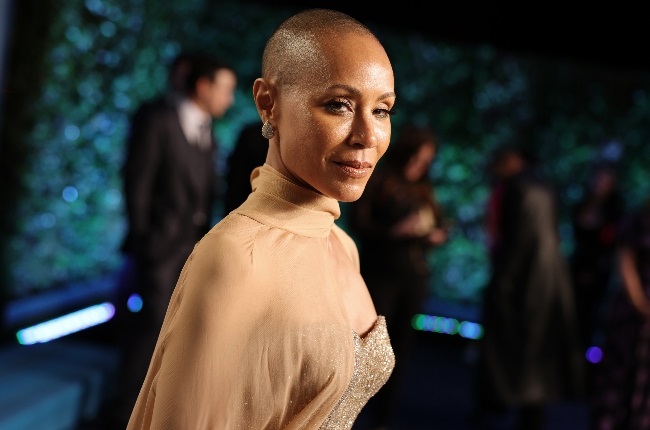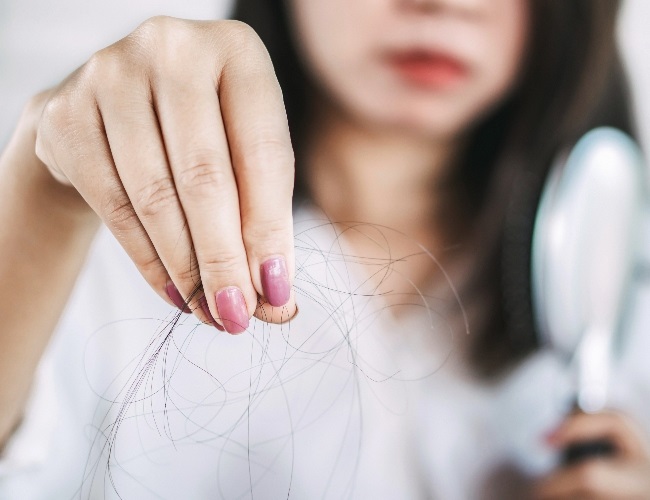
It is one of those TV moments people will talk about for a long time: Will Smith getting up from his seat, walking onto the Oscars stage and smacking Chris Rock after he makes a joke about Will’s wife Jada Pinkett Smith’s hair, or lack of it.
While many disagree with the way the actor, who ended up winning an Oscar for King Richard, handled the situation, it also shone a new spotlight on Jada and her hair condition.
Jada, who rolled her eyes in disgust at Chris’ Demi Moore G.I. Jane 2 reference, has always been an open book when it comes to her struggles with alopecia.
In 2018, the now-50-year-old actress and Red Table Talk host opened up about dealing with the autoimmune disorder that causes hair to fall out in small patches. She started by saying she’d received many questions about why she was wearing turbans before saying she has alopecia, admitting how “terrifying” it was when she first experienced hair loss.
“I was in the shower one day and had just handfuls of hair in my hands and I was just like, ‘Oh my God, am I going bald?’ It was one of those times in my life where I was literally shaking in fear. That’s why I cut my hair, and why I continue to cut it,” an emotional Jada said at the time.
Jada, who was often seen sporting shorter hairdos and wearing her turbans on Red Table Talk, said that at one point she even resorted to taking “steroid injections” and looking at other ways to stop it. “They seem to be helping, but not curing,” she said.
Then in July last year, she took the bold step and debuted her fully shaven head, crediting her daughter, Willow, who encouraged her to go bald. “Willow made me do it because it was time to let go. My 50s are ’bout to be divinely lit with this shed,” she captioned a picture of the two of them.
During a Red Table Talk interview with Tiffany Haddish and Yvonne Orji last year, Jada also said her decision to shave it all off gave her a sense of freedom. “It was a huge relief. It was that moment, I was just like, ‘I’m done. I’m done with the worry, I’m done with the care. I’m just done’,” she said.
Jada said she also realised that there were people worse off than her and that gave her peace.
“Even in my terror and even in my fear and in the moment of just going, ‘Oh, my God, like, why are you so terrified that you might lose your hair?’ I really had to put it in a spiritual perspective of, like, the higher power takes so much from people. People are out here who have cancer, people who have sick children. And, by golly, if the higher power wants to take your hair, that’s hair? When I looked at it from that perspective, it really did settle me,” she added.
Now the mom-of-two says she is at a point where she can laugh about it, celebrate it and live boldly as a baldy.
We look at what causes hair loss and the treatments available.
TYPES OF TREATMENTS
Hair loss is often temporary, but may become more permanent as a result of ageing or other factors, according to trichologist Simone Lee.
“There are many treatments for hair loss and thinning. However, only a number of ingredients have proven to be effective or produce results, including hair regrowth,” she says, citing minoxidil and aminexil as examples.
“Common hair-loss treatments may appear in the form of specialised haircare products, including topical ointments and medications.”
Although not treating the cause of thinning hair, thickening shampoos, conditioners and styling products can help hair appear fuller.
Hair is made up of a protein, keratin, which originates in follicles beneath the skin.
"As new keratin is produced, old cells are pushed up the follicle and through to the skin's surface," trichologist Simone Lee says.
"These strings of dead keratin cells are what we see as hair. Hair on the scalp is growing 90 percent of the time. The life cycle of each follicle is divided into three phases [anagen, catagen and telogen] – the hair growth cycle."
THE CAUSES OF HAIR LOSS
“Scalp hair grows approximately 1cm a month,” Lee explains. “The rate of growth can be affected by various skin disorders that cause damage to the hair follicles, hormonal changes, nutritional deficiencies, surgery or prolonged illness, reactions to medications, age and genetic predisposition.”
Hairdresser Kenneth Stoddart says several of his female clients display signs of thinning hair. “I usually find that hair can thin around six months after something stressful has happened and [it] can take another six months to come back to normal.
“Childbirth is also a major cause of thinning hair, particularly around the temples. Again, this can take anywhere up to one year for the hair to grow back and, in some cases, the hair doesn’t grow back entirely as it was.”
SIGNS AND SYMPTOMS
“Men, women and children often present different signs and symptoms of hair loss,” Lee says. “At any age, hair loss found in hairbrushes, on the bathroom floor and in drains may be a visible concern to the sufferer.”
Some women may find that their scalps are more noticeable in their part line, while men may experience a receding hairline.
“Other signs may be a sudden loss of hair in patches, or patches of broken hairs on the scalp,” Lee adds.
It’s also common for women to find they’re able to do more loops with their hair elastic because their ponytail has become thinner. It’s not a cause for panic. Instead, seek advice from a medical professional to determine the cause and the best treatment option for you.
READ MORE | Hair to dye for! We take a look at the most popular dyeing trends and how they differ
“The key is to start treatment early,” says Dr Eleni Yiasemides. “There are lots of infomercials promising ‘miracle cures’, which are false and add to a woman’s disappointment and cynicism about this condition and its treatment.”
Yiasemides also says it usually takes around six months of topical treatments to see a result for male or female pattern hair loss and that the primary purpose of this form of treatment is to stop the condition worsening.
“There is no cure or prevention – all treatment is life-long,” she says
WHAT YOU CAN DO
There are several lifestyle changes and steps you can take to boost hair volume and prevent further hair loss.
1 Get the right cut
“One of the best things to do is to visit your hairdresser and have a haircut that helps to thicken the end of the hair," advises hairstylist Kenneth Stoddart. “It is possible to make the hair look thicker by changing the parting to the opposite side or take an uneven staggered parting, which will give lift around the parting and appear fuller.”
2 Opt for thickening products
“Use products like thickening sprays and body-building mousses as they will help to give the hair a ‘fuller’ look,” Stoddart says.
3 Improve your diet
“Nutrition is very important in maintaining a healthy hair growth and regeneration cycle,” explains trichologist Simone Lee. Wholegrains (biotin and silica), lean protein and green vegetables can improve hair regeneration, while alcohol and caffeinated drinks may have a negative effect.
4 Exercise
“Regular exercise is highly beneficial to our health and wellbeing, but heavy exercise regimens are often associated with the disruption of the hair-growth cycle, as the body may be put under enormous stress,” Lee says.
5 Care for your hair
Harsh chemicals on the scalp and hair, and tight braids or hair extensions, may further damage hair strands. Use a soft-bristle brush gently.
6 Minimise stress
“Stress can cause the blood vessels to become constricted, which can slow the process of hair growth,” Lee says. Ensure you’re getting enough sleep and try meditating or breathing techniques to manage stress.
CREDIT: AREMEDIA.COM.AU/MAGAZINEFEATURES.CO.ZA
SOURCES: PEOPLE.COM, ALLURE.COM, DAILYMAIL.CO.UK, USWEEKLY.COM




 Publications
Publications
 Partners
Partners




















